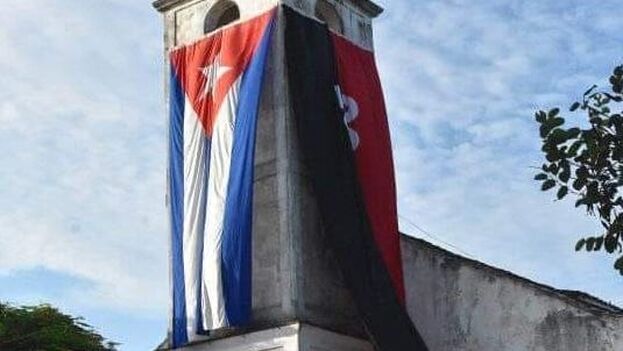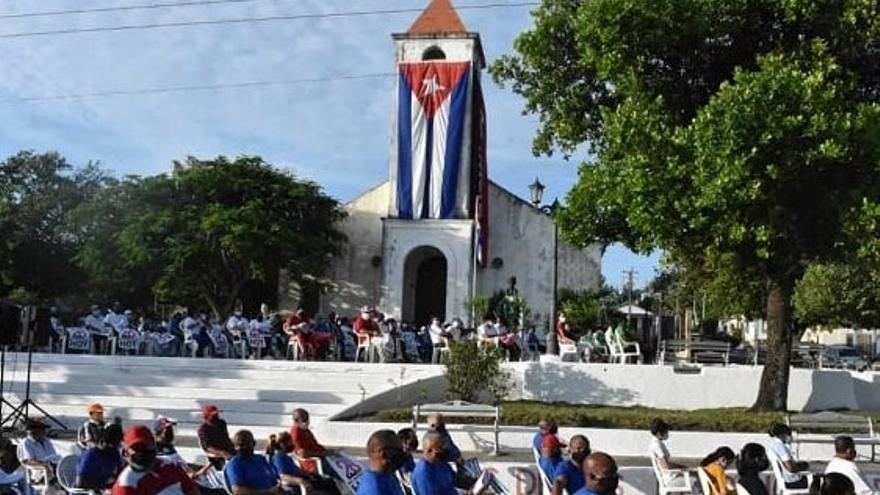
![]() 14ymedio, Havana, 26 July 2021 — The placement of the 26th of July Movement’s red-and-black flag on the facade of a church in Corralillo (Villa Clara province), annoyed the parishioners and obliged the bishopric of the diocese to publish a note lamenting the event and calling for the churches not to be involved in “political acts.”
14ymedio, Havana, 26 July 2021 — The placement of the 26th of July Movement’s red-and-black flag on the facade of a church in Corralillo (Villa Clara province), annoyed the parishioners and obliged the bishopric of the diocese to publish a note lamenting the event and calling for the churches not to be involved in “political acts.”
On July 26, Corralillo was the “headquarters” of the official celebrations in Villa Clara, with the visit of Communist Party’s highest provincial authorities, who echoed the model of the commemoration in Havana, dedicated to productive tasks or visits to centers of economic value, such as the volunteer work in which Miguel Díaz-Canel participated in an urban garden.
During the commemorative event for the official Day of Rebellion, the Corralillo church was adorned with two gigantic flags: the national ensign and the one alluding to the Movement that emerged after the attack on the Moncada Barracks in Santiago de Cuba, on July 26, 1953, a date on which dozens of young people under the command of Fidel Castro died.
After the image of the church with the two flags was disseminated in the local media, the press office of the bishopric of the province, based in Santa Clara, felt obliged to publish a text in which it emphasizes that “it is the principle of the Church that our temples are not involved, under any circumstances, in political acts.”

The note indicates that the placement of the red and black flag generated “the concern of many for this unusual event.” The statement clarifies that “the religious congregation in charge of this temple is made up of foreign nuns, recently installed in the place,” as an explanation of why it took them some time to realize the political nature of the display.
“In communication with the mother superior, she lets us know that authorization was requested to place the Cuban flag, without mentioning any other symbol.” The note continues to say that “in the Diocese, the only authority competent to authorize a matter of this nature is the diocesan bishop, who had no knowledge of this matter.”
“We regret what happened, and we trust that events like this will not be repeated,” concludes the document signed by the Vicar General of the Diocese of Santa Clara, Arnaldo Fernández Berroa. The note, published on the diocese’s Facebook page, is accompanied by a photo taken from the local official press.
The flag of the M-26-7 has for decades represented a political movement, involved in several violent events in Havana and armed struggle in the mountains of eastern Cuba. This banner is frequently placed in official and partisan entities, as well as in public places during the commemoration of the anniversary.
This Monday the celebrations have been atypical, just two weeks after the protests that took place in more than 40 cities throughout the island and the consequent repression. “More than the Day of National Rebellion, it seems the day of national sadness,” says a neighbor from Centro Habana as she gazes at the door of La Época store, lacking its usual lines of customers waiting outside.
The ruling party called on its followers to place Cuban and M-26-7 flags on balconies and facades, but, in a tour of several municipalities, this newspaper confirmed that the presence of the ensigns was scarce, in part because for decades they could only be bought in convertible pesos or were given to officials and high officials.
“In my block only one family took out a flag and played music with speakers on the balcony, but no one responded to the rhythm,” a resident of Cayo Hueso in the Cuban capital told this newspaper. “People are very quiet and in no mood to celebrate.”
____________
COLLABORATE WITH OUR WORK: The 14ymedio team is committed to practicing serious journalism that reflects Cuba’s reality in all its depth. Thank you for joining us on this long journey. We invite you to continue supporting us by becoming a member of 14ymedio now. Together we can continue transforming journalism in Cuba.
